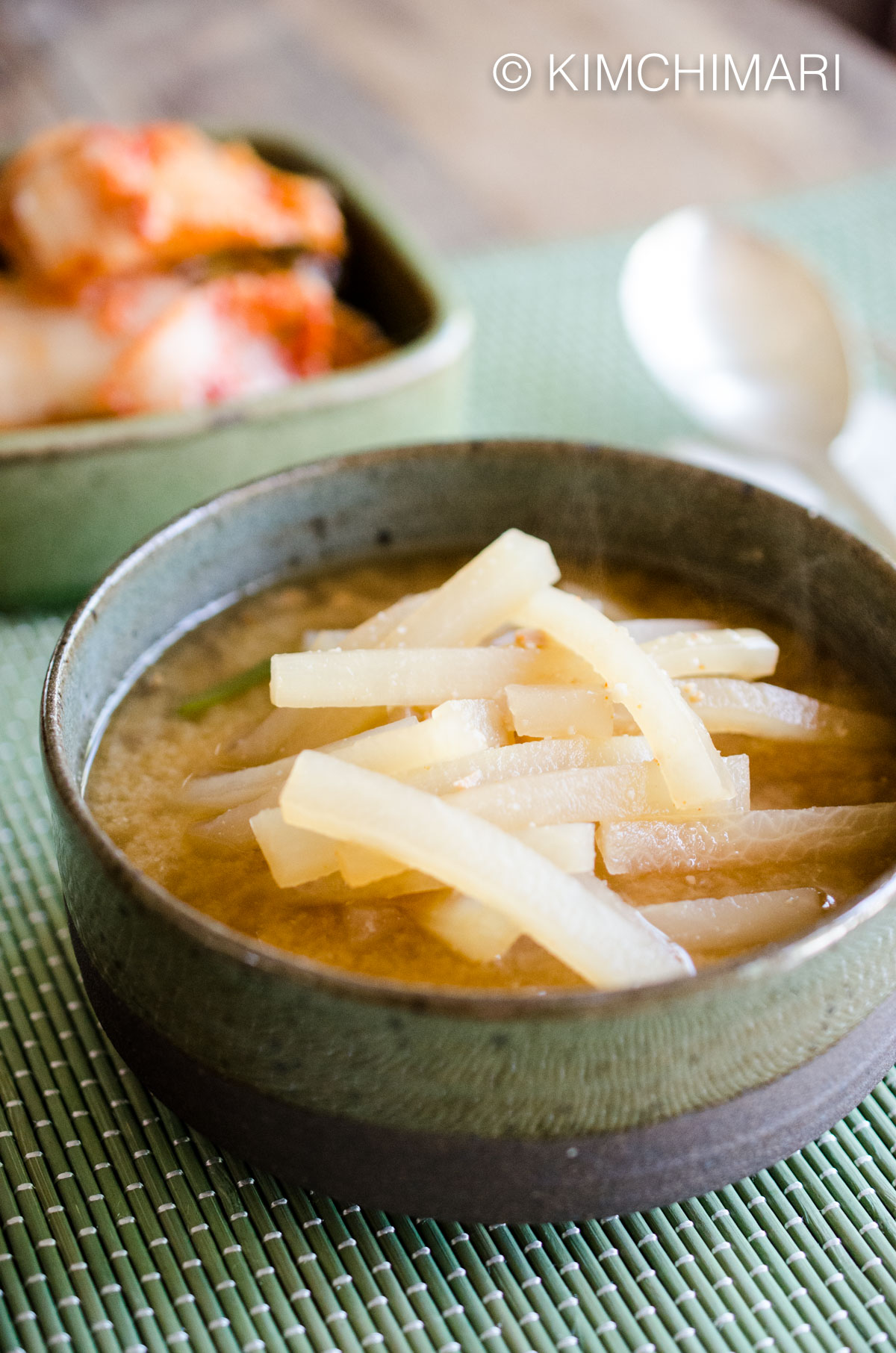
Radish Soup (무된장국 Mu Doenjang Guk) – the most comforting, soothing, umami flavor packed Korean dish that is truly a ‘brings-me-back -home’ kind of a soup.
Radish Soup!!?? Yes, in Korean it’s MuDoenjang Guk. Mu 무 = radish, Doenjang 된장 = soybean paste, Guk 국 = soup.
Now that fall is just around the corner (or is it here already?? 😜)…I feel the sun getting weaker and the air getting more crisp and clean, refreshingly cool. Such a welcome end to an unusually hot summer’s end here in California. Especially with my aging body which has trouble regulating temperature… sigh…Anyway, so fall is getting me excited about blogging some new recipes! So, I thought about a warm soup.. is there any soup that I have not yet blogged about??? Hmm…
And then it came to me…
BTW, if you were thinking of the clear beef broth based radish soup (which is called just MuGuk 무국) – then I am sorry, this is not it. It’s on my list to do’s though, so please be patient. 😉 The clear MuGuk is probably better known because it is served at restaurants and homes a lot more.
However, this Radish Soybean Paste Soup was made quite often in my home when I was little. Even though there’s no meat in this soup, it is so hearty that this Korean Radish Soup + Rice + Kimchi will still leave you feeling very satisfied.
So this is another one of those dishes that I haven’t cooked as often as I would have liked because of my husband. Oh.. the things we do for our husbands…
I know I talked about how COLD foods don’t go well with my husband before on previous posts. WARM foods like chicken, apple and cabbage warms him up while on the other hand, COLD foods like pork, pear and radish cools him down too much.
As soon as I got married, my mother-in-law warned me about him with COLD foods. So for 25+ years, I tried to cook warm foods for him. I did so not only because of my mother-in-law’s advice but I witnessed, first hand, the difference of how COLD/HOT foods affected him. His eyes get all red, nose gets stuffy or runny (like an allergy) and he just doesn’t feel good. Because the different foods don’t seem to make much difference to me, I tended to make warm foods most of the time.
Interestingly, over the years, my husband has grown less sensitive to COLD foods. So I am now able to cook dishes that I have not prepared often which I love. So basically, I am trying to say that I am now planning to make the radish soup more often cause it’s so EASY to make and it’s sooo good.
Radish Nutrition
BTW, don’t think Radish is not good for you. It is only a problem if you have a very COLD body which is not the case for many people. Overall, it is low calorie, high in fiber and high in vitamin C. Which is a great food to have for fall and winter months to keep off flu and colds. Radish also has anti-cancer properties and is great for digestion with digestive enzymes ( diastase, amylase, and esterase).
Radish Soup and Korean Soybean Paste (Doenjang) – what I like to use
Because soybean paste is such an important part of this dish, I can’t stress enough how important this ingredient is for this recipe. I know I have discussed about Korean soybean paste (Doenjang) before in this post but let me just briefly show you the 4 kinds that I like to use for Korean cooking.
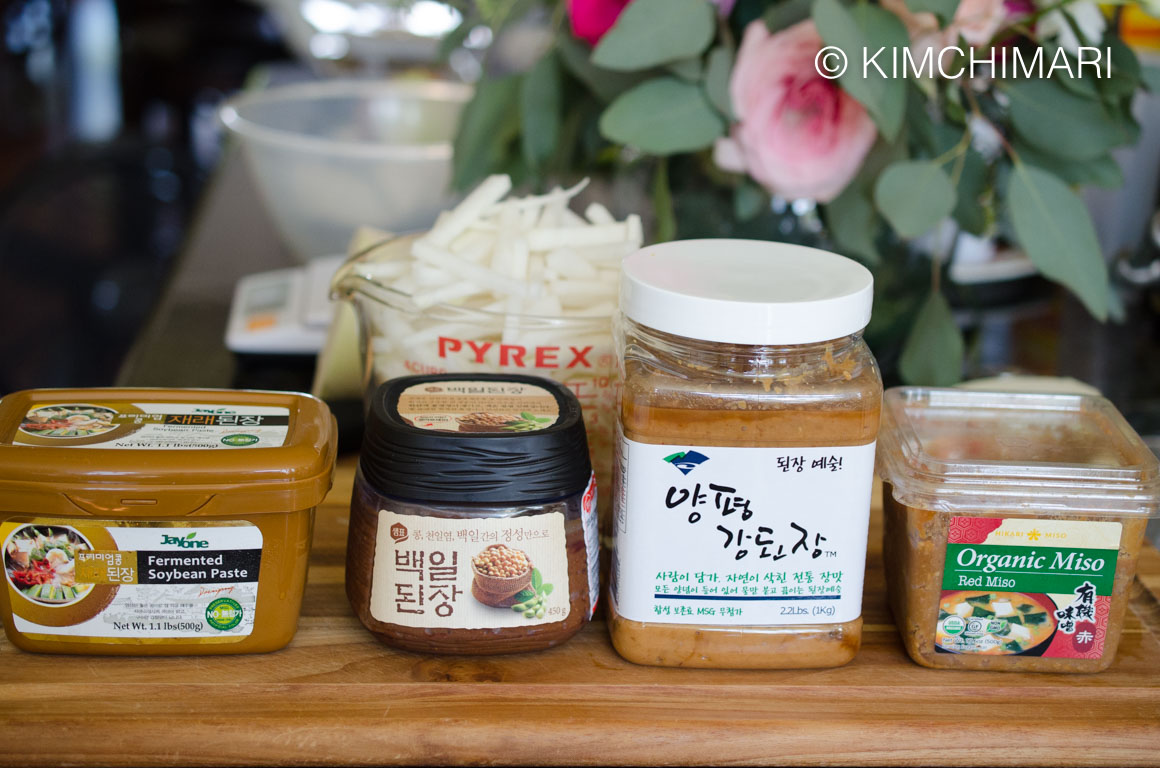
From LEFT to RIGHT:
- Jayone- Fermented Soybean Paste – this is the one that I see most often at regular American grocery stores (at least in bay area) and is OK in terms of quality of ingredients. No MSG, Non-GMO, but there’s Wheat in it. Flavor wise, it is kind of bland, lacking the deep umami flavor but does the job.
- Sempio – Baekil Deonjang (백일된장) – this is quite salty but has good umami flavor and is made close to traditional method of going through 100 days of actual fermentation. Contains just soy bean, salt, distilled alcohol, and koji starter. Use sparingly but a little goes a long way in adding that extra deep flavor. Unfortunately this is only sold at some Korean grocery stores. Here’s one by Chungjungone that’s the closest: http://a.co/djTh4jY
- Yangpeong – Gang Deonjang (양평 강된장) – Gang Deonjang 강된장 refers to ‘seasoned’ doenjang. It is usually seasoned with broth and other ingredients like mushrooms, garlic, green onions, chili peppers..I did not use this in this recipe but it is a good soybean paste to use for Jjigae.
- Organic Red Miso – yes, it’s Japanese soybean paste but I use it to round out any Korean soybean paste soups when it seems to taste too harsh or salty. Red miso is more flavorful than white miso. Buy it here – http://a.co/hDvNq9r
Korean Radish Soup Recipe (Mu Deonjang Guk)
Servings: 6-7 Cooking Time: 50 min Difficulty: EASY
Ingredients
- 1 oz (30g) dried anchovies for soup (guk myeolchi 국멸치)
- 1 pc dried kombu kelp (dashima 다시마), approx 3.5 in x 1.5 in
- 8 cups water
- 1.25 lb (600 g) Korean radish (mu 무) or 5 to 5 1/2 cup julienned
- 3 Tbs Deonjang (I used Jayone here)
- 1 Tbs red miso
- 1 Tbs Jaerae Doenjang (재래된장 Traditional slow fermented) – optional but best for flavor
- 1 tsp Guk Ganjang (Soysauce for Soup) – optional to taste
- 1 Tbs garlic, chopped (if using frozen, add more)
- 1 tsp garlic powder
- 2 green onions
- 1/2 tsp red chili powder (gochukaru 고추가루)
- Add 8 cups of water to pot. Add dried anchovies and dried kombu kelp. Heat on medium low heat for 20 min. Keep it uncovered at low simmer without any bubbling.
- While anchovy stock is developing, cut radish into large chunks.
Radish for Radish Doenjang Guk Then peel the skin off of each chunk with a knife. You can also use a peeler but this radish was a little old and so I needed to take off more skin. If radish is fresh and skin is thin, you can just use a peeler.
Peeling Radish for Mu DoenjangGuk - Cut each chunk into slices
Julienne Radish for SoyBeanPasteSoup Then julienne into thin 0.5 cm (0.2 inch) match sticks.
Korean Radish Soup ingredient A little thicker or about the same as size of shoestring fries.
- When anchovy stock is ready (yellowish color), remove anchovies and kelp from pot using a tool like this one –
Dried Anchovies and Kelp after making Stock - Add all 3 soybean pastes from above – if you have them. If not, just use 3 or 4 Tbs Korean soybean paste (whatever you have) and 1 Tbs red miso to pot. Mix well into soup by smooshing the paste against the side of the pot with a spoon and swishing it around.
Mu DoenjangGuk (Korean Radish Soybeanpaste Soup) - Add radish sticks to soup and bring to boil on medium high heat.
Radish in Korean Radish Soup Mu Deonjang Guk - Simmer for 25 minutes or more until radishes are soft and tender. You can cover or leave it uncovered during this time. Always remember to check how much it’s boiling if you keep it covered because it always boils at lower temperature when it’s covered.
- Add cut green onions, chopped garlic and garlic powder and simmer for 5-10 more minutes.
Mu Doenjang Guk (Radish Soup with Soybean paste) - Taste the soup. Add 1 tsp guk ganjang if you think it can use a little more salt. Remember guk ganjang not only adds salt but also tons of umami flavor so add this if you think it lacks that something.
- Radish should be tender and totally soft.
Radish Soup closeup (Mu Deonjang Guk) Finish with some red chili powder (gochukaru). Add more to taste.
Radish Soup with Soybean paste and chili powder Radish Soup Korean MuGuk Radish Soup and Rice (Korean Mu Doenjang Guk)
Korean Radish Soup (Mu Doenjang Guk)
Ingredients
- 1 oz dried anchovies for soup (guk myeolchi 국멸치)
- 1 piece dried kombu (kelp) or dashima 다시마 (approx 3.5 in x 1.5 in)
- 8 cups water
- 1.25 lb Korean radish (mu 무) (5 1/2 cups julienned)
- 3 Tbsp Deonjang (I used Jayone here)
- 1 Tbsp red miso
- 1 Tbsp Jaerae Doenjang (Traditional slow fermented - optional but best for flavor)
- 1 tsp Guk Ganjang (Soysauce for Soup - optional to taste)
- 1 Tbsp garlic (chopped. if using frozen, add more)
- 1 tsp garlic powder
- 2 green onions
- 1/2 tsp red chili powder (gochukaru 고추가루)
Instructions
- Add 8 cups of water to pot. Add dried anchovies and dried kombu kelp. Heat on medium low heat for 20 min. Do not boil.
- While anchovy stock is developing, cut radish into large chunks and then into slices, then julienne into thin 0.5 cm (0.2 inch) sticks. A little thicker or about the same as size of shoestring fries.
- When anchovy stock is ready (yellowish color), remove anchovies and kelp from pot.
- Add all 3 soybean pastes from above if they are available. If not, just use 3 or 4 Tbs Korean soybean paste (whatever you have) and 1 Tbs red miso to pot. Mix well into the soup by smooshing the paste against the side of the pot with a spoon and swishing it around.
- Add radish sticks to soup and bring to boil on medium high heat.
- Simmer for 25 minutes or more until radishes are soft and tender.
- Add cut green onions, chopped garlic and garlic powder and simmer for 5-10 more minutes.
- Taste the soup. Add 1 tsp guk ganjang if you think it needs a little more salt. Remember guk ganjang not only adds salt but also tons of umami flavor so add this if you think it lacks that something.
- Finish with some red chili powder (gochukaru). Add more if you want it more spicy.
Tips & Notes:
Nutrition Information:
Radish Soup Notes
- Serve with rice, kimchi and other side dishes. It will make a wonderfully simple but comforting meal. Make a large pot and reheat as you need it. It actually taste better the next day.
- Using this basic broth + doenjang guk making recipe, you can make this wonderful soup
Korean Cabbage soup or Baechu Deonjang Guk with other vegetables like kale, spinach (use less doenjang for this one) and cabbage. BTW, here’s my old Baechu Doenjang Guk recipe if you want to try making with beef.
- Gluten Free – as usual this can be naturally gluten free as long as you can get gluten-free soybean paste and soy sauce.
Happy Fall!! ENJOY!!
XOXO ❤
JinJoo

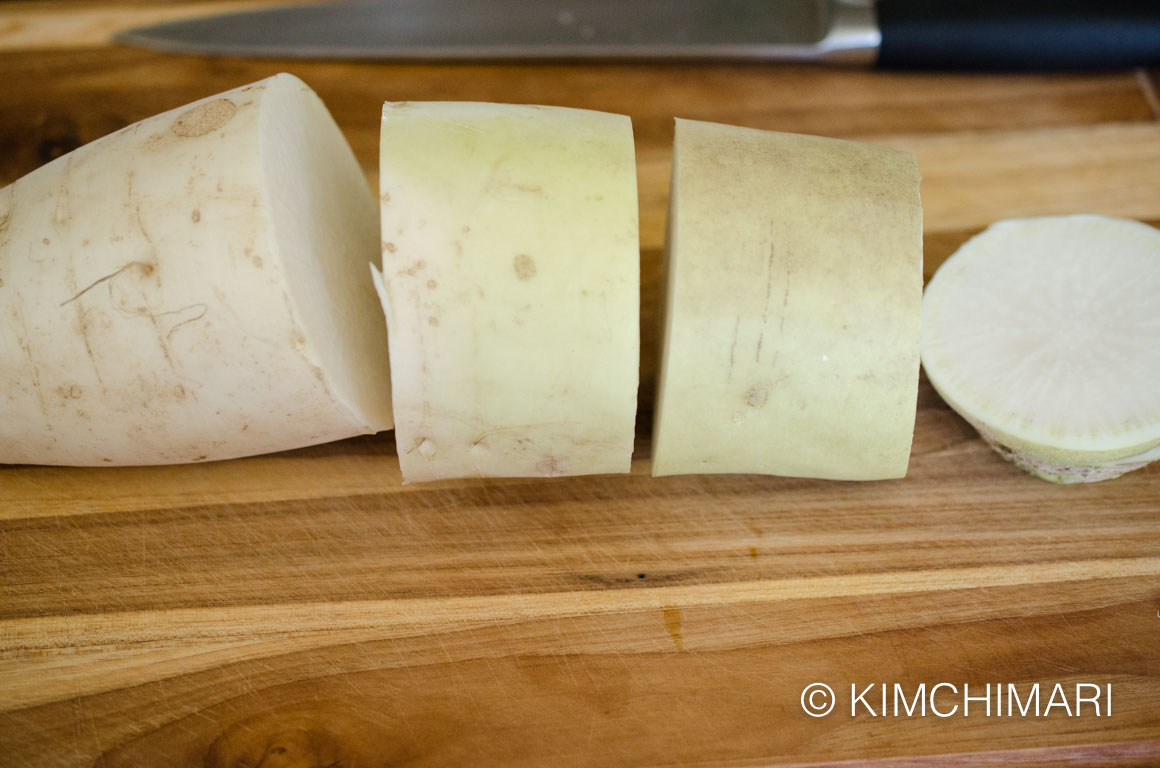
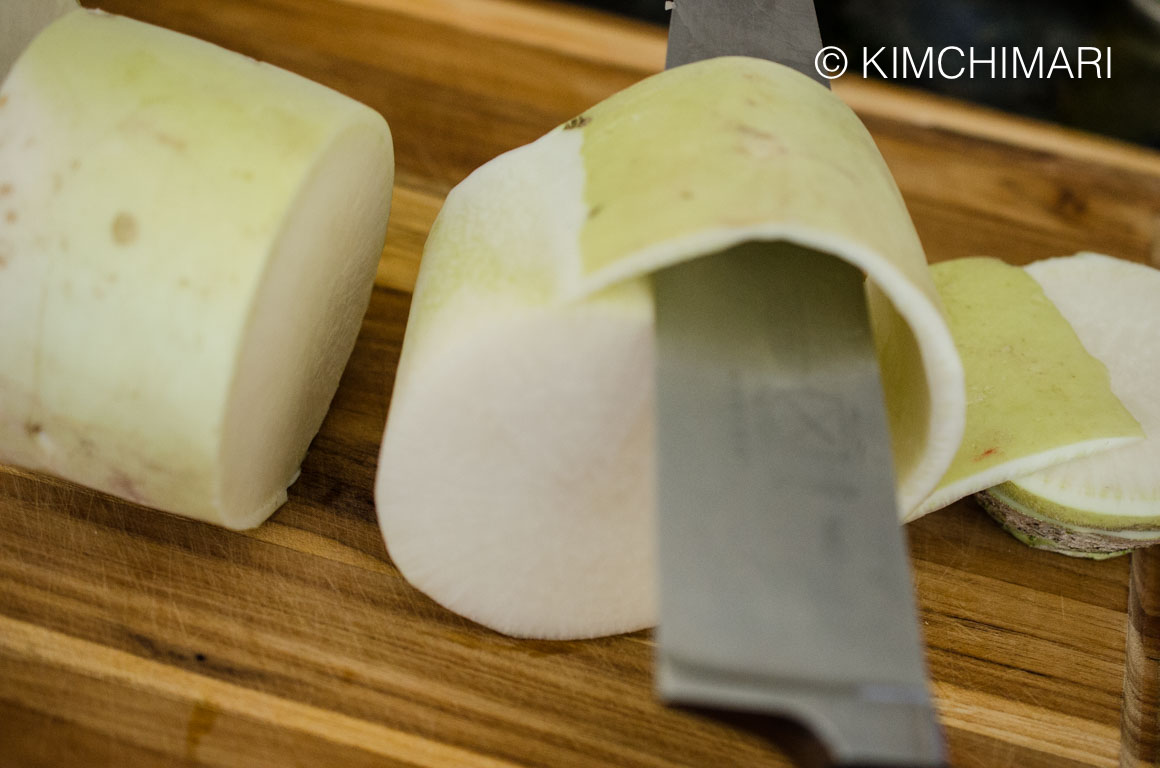
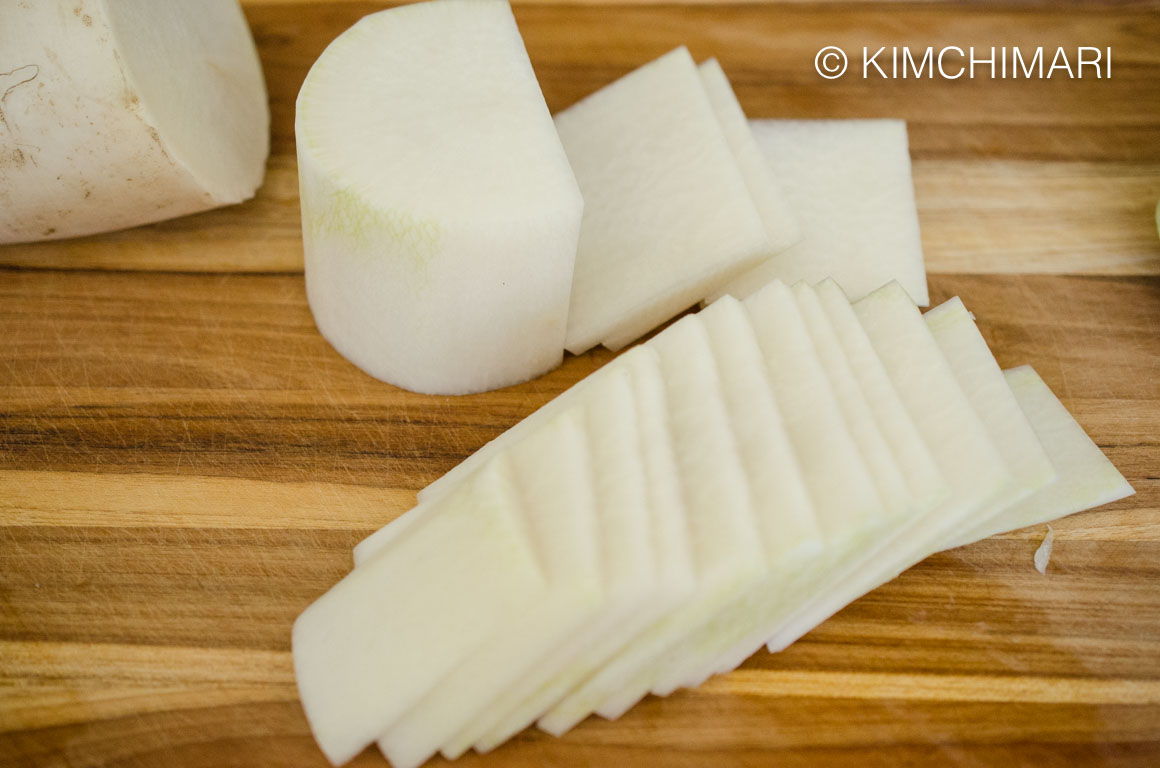
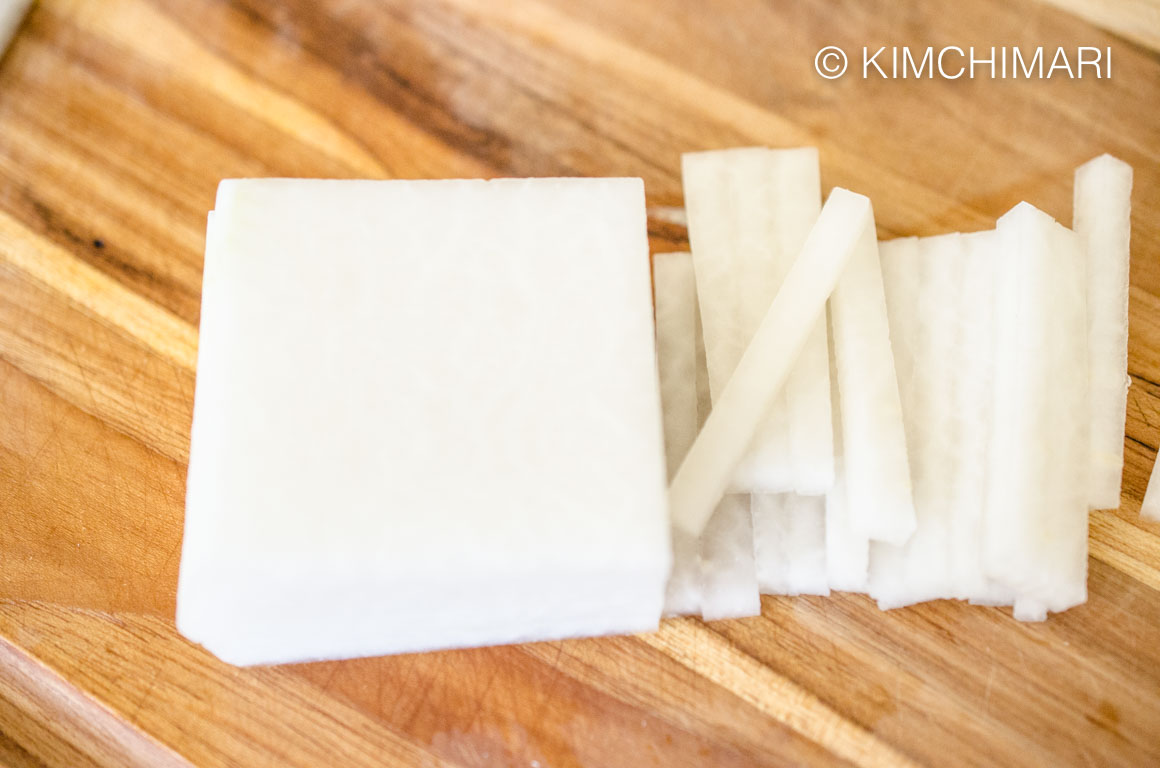
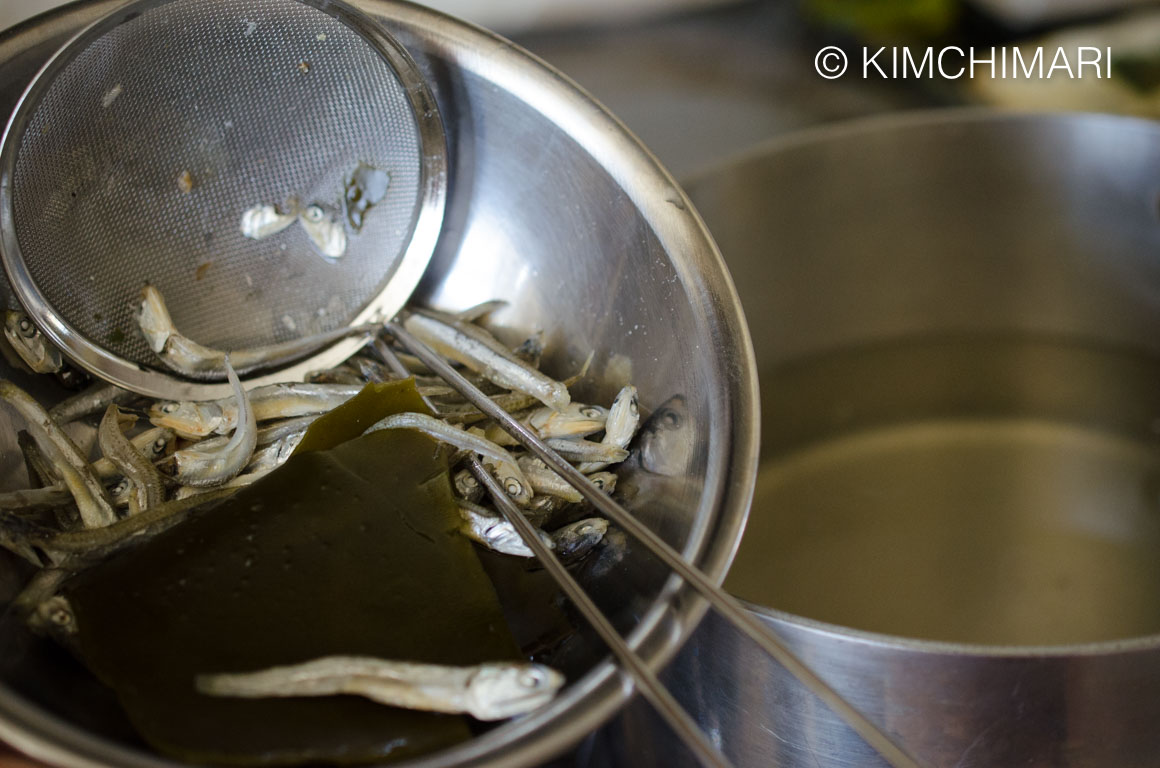
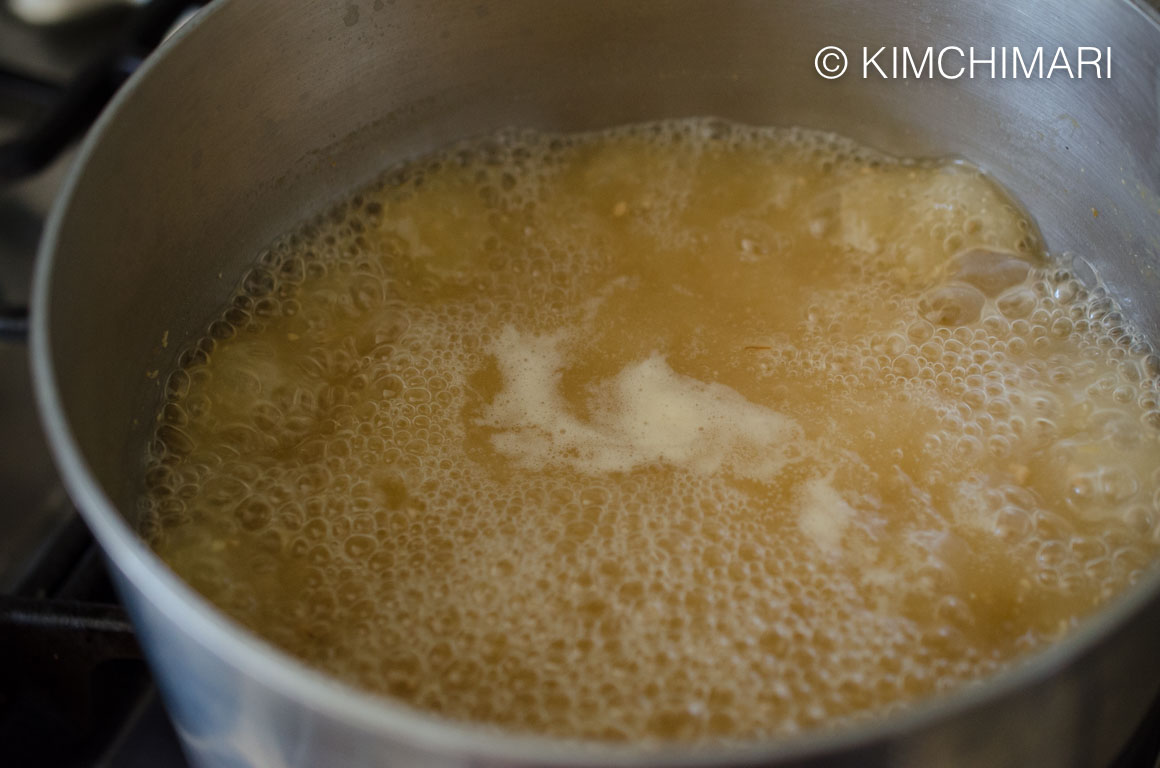
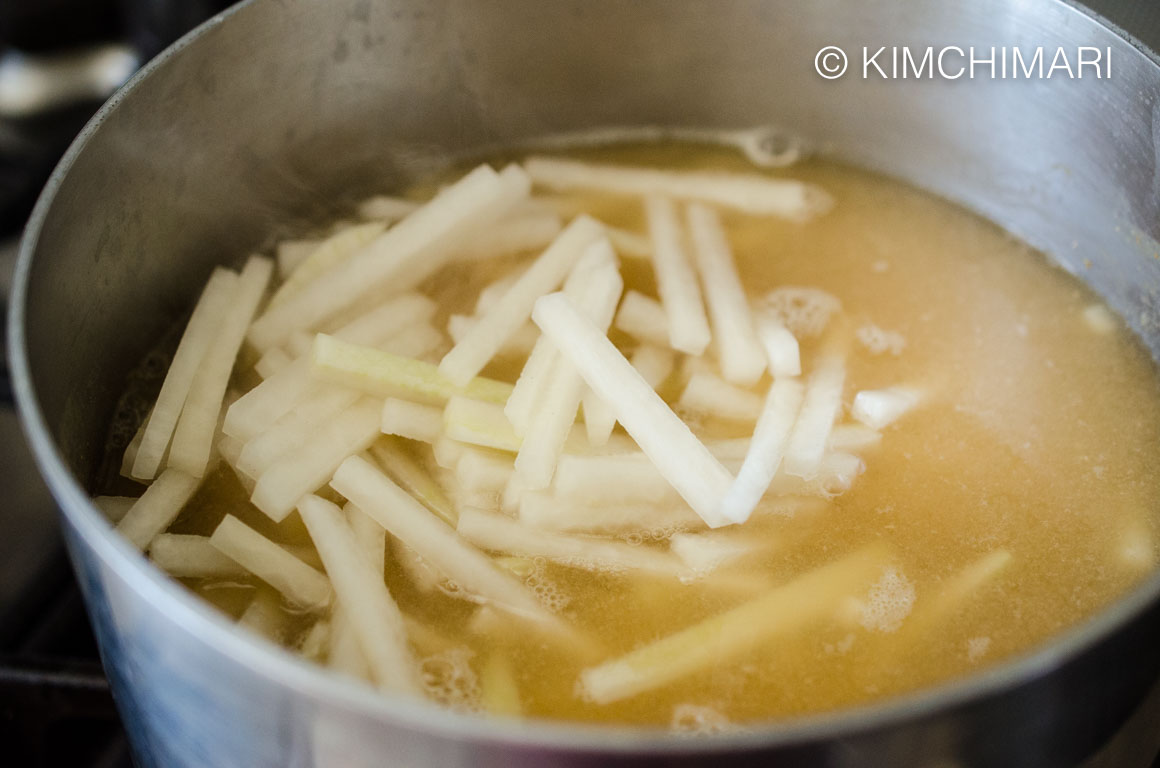
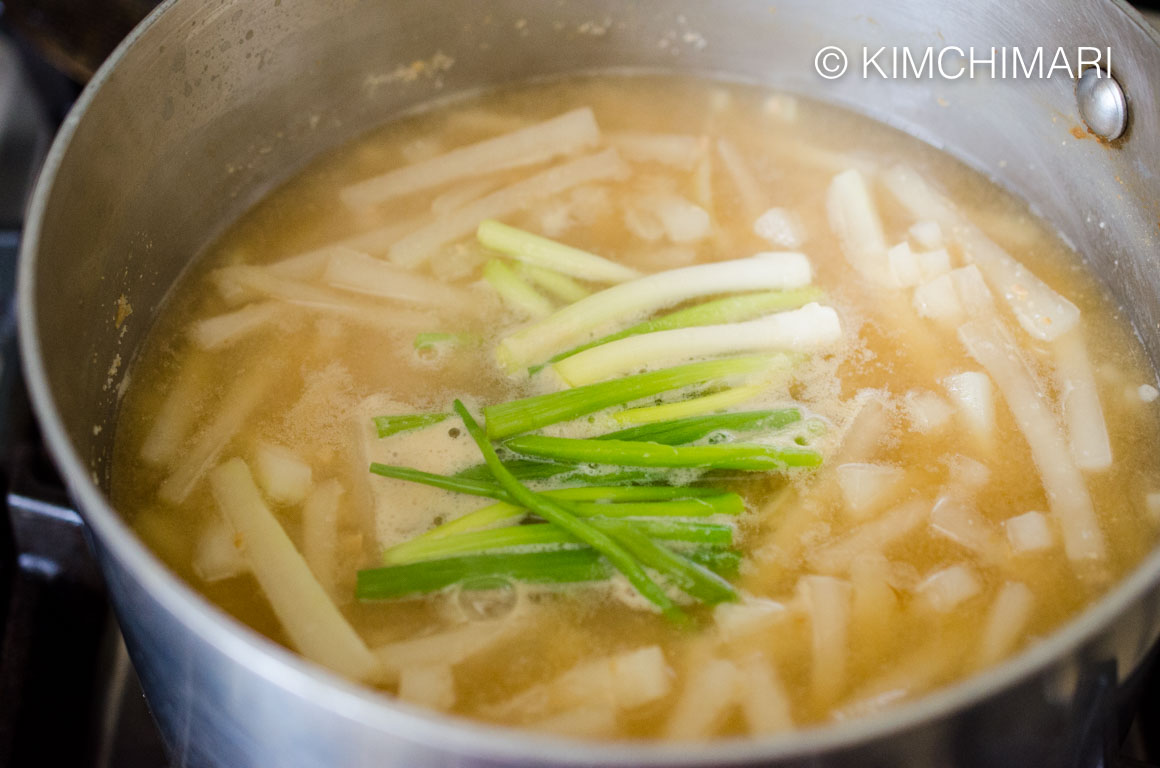
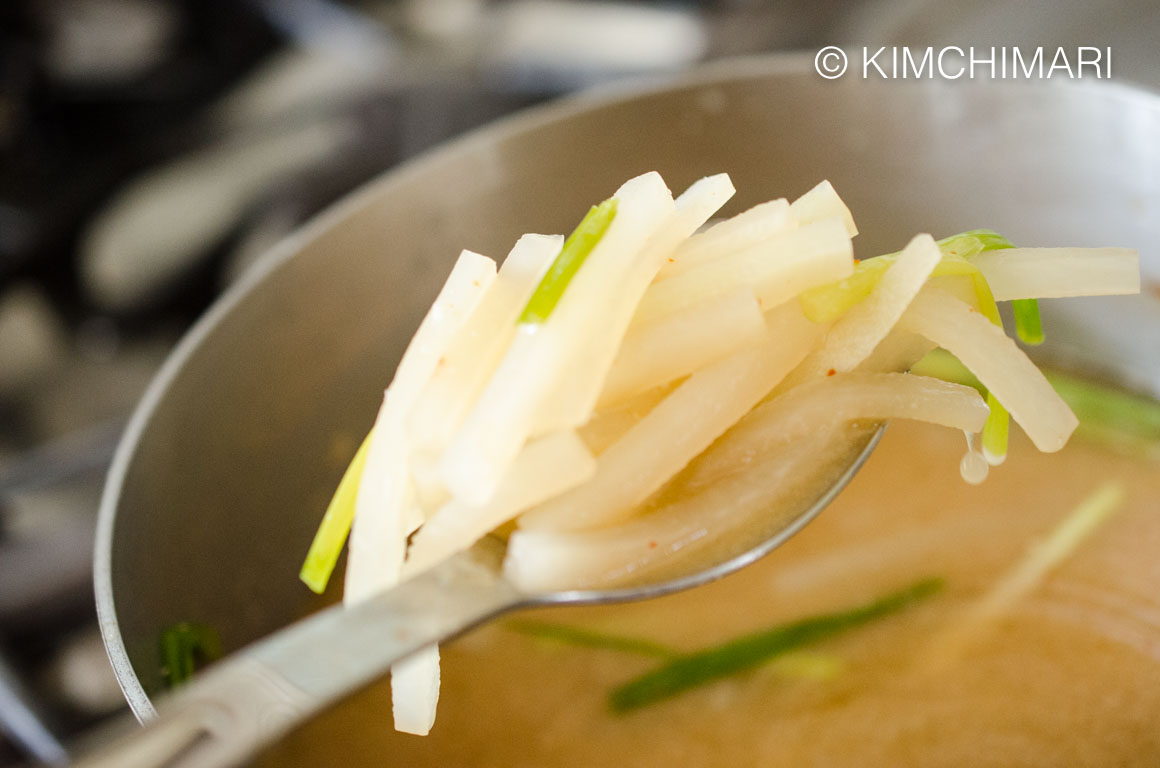
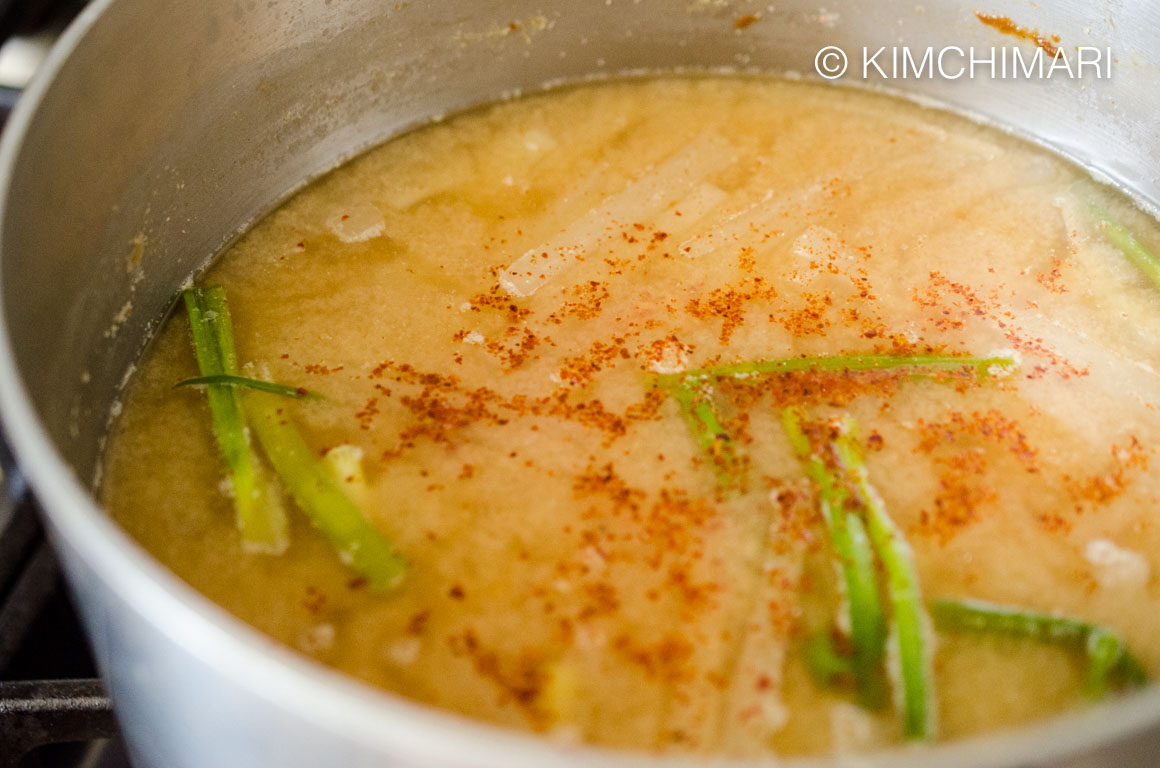

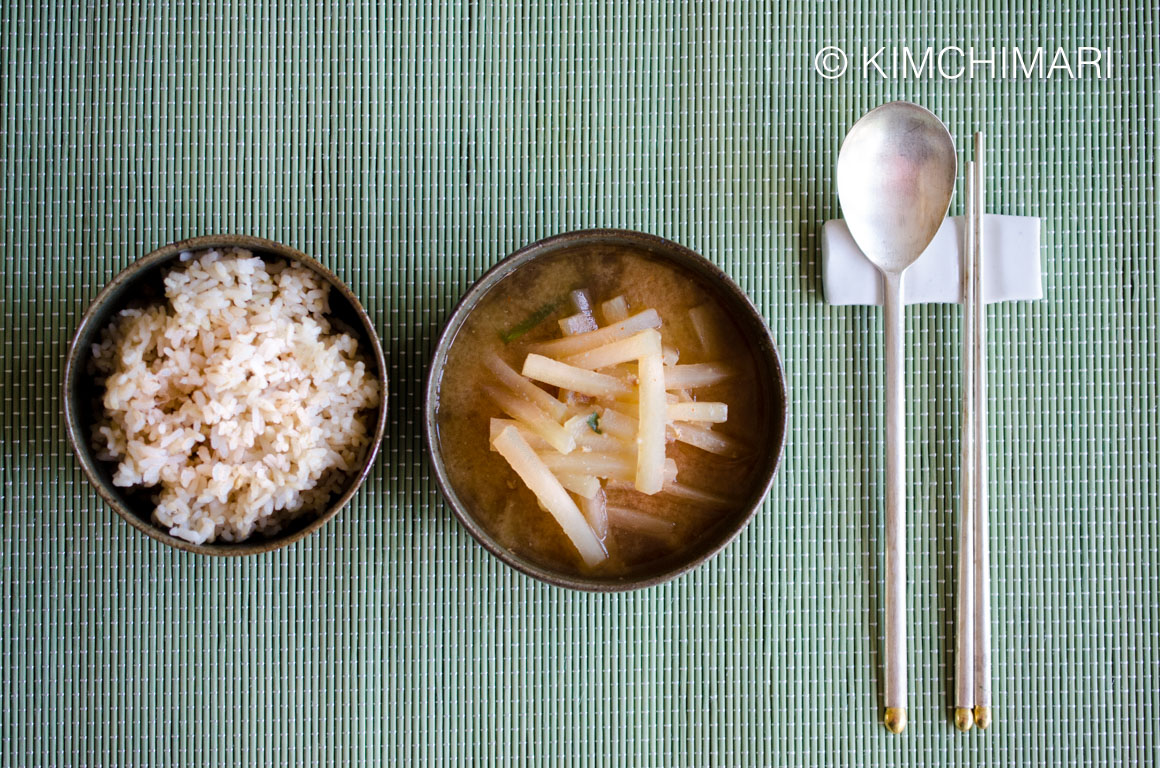
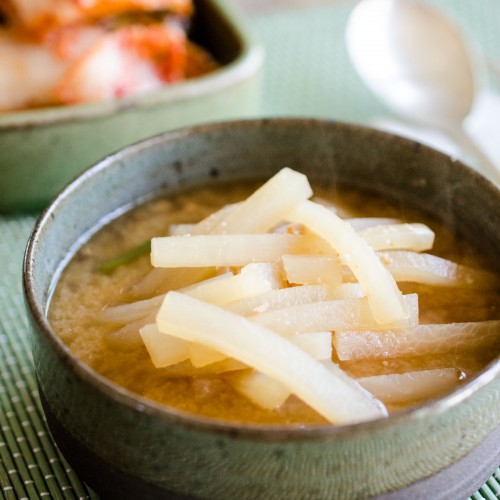



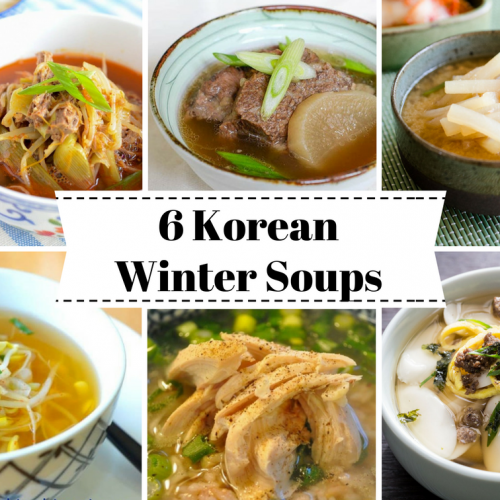
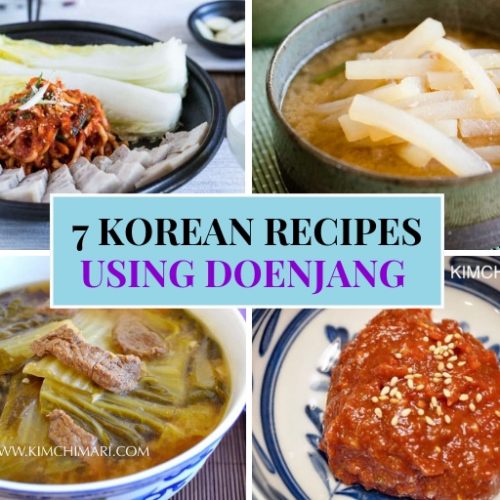
















had no beef in the fridge. this recipe saved me! yummy
Brilliant!! So glad I was able to help! Thank you.
I am going to try to make this soup. I am onje of those people needs hot foods, I am always ice cold. I have been reading through your recipies for quite some time my only concern is that I have HER2 Cancer and cannot eat estrogen products like soy so can you think about recommending substitutes for your soy pastes. Thank you Judy
Hello Judy,
I’m so sorry to hear about your cancer. That must be so hard.. I am afraid there isn’t a really good substitute for Deonjang or Gochujang that doesn’t use soy. I would just recommend making other soups that don’t use soy bean pastes? Most of the soups here don’t use any paste. https://kimchimari.com/korean-soups-recipes-guk-winter/ Hope that helps. Good luck!
I would love to make this but I’m vegetarian so i meed to omit the anchovy. Is it ok just making with seaweed? Or should i add some dried mushrooms for the umami? If so please let me know which ones you recommend.
I think it should be OK to just use a Kombu/Dried Kelp broth. You can try adding some dried mushrooms and maybe some onions? If using dried mushrooms, definitely shitake is the one to use – it goes best with Korean flavors. I have never personally tried making it with just kelp or with mushrooms so I would love to hear how it turns out. Always good to know how it tastes when you change the ingredients. Thank you for trying my recipes!
안녕하세요 JinJoo!
I just discovered your blog and I am excited to read through all your posts now. I started at the, “Know your Doenjang” post. I usually buy JayOne products in L.A. but I am far away at the moment and purchased Haechandle Doenjang… anyway, I am intrigued by your Cold vs. Hot foods information. Do you have links on your site so I can learn about this? I’m wondering which one I am. And in closing, this recipe looks great and I am going to have it for breakfast tomorrow! 🙂
Hi Ava,
So glad you found my blog! Yes, Cold vs Hot foods is very interesting and I would have never believed in it until I saw it firsthand with my husband. Unfortunately I don’t have any links on my blog right now but I will try to either find something soon or I may write about it. Please follow my blog and I will keep you updated! Thank you!
This recipe seems delicious!! Thanks for sharing it, I’ll sure try making it!
I really hope you do Isadora! Certainly my favorite of all soups – so comforting and delicious! thanks so much for your comment!